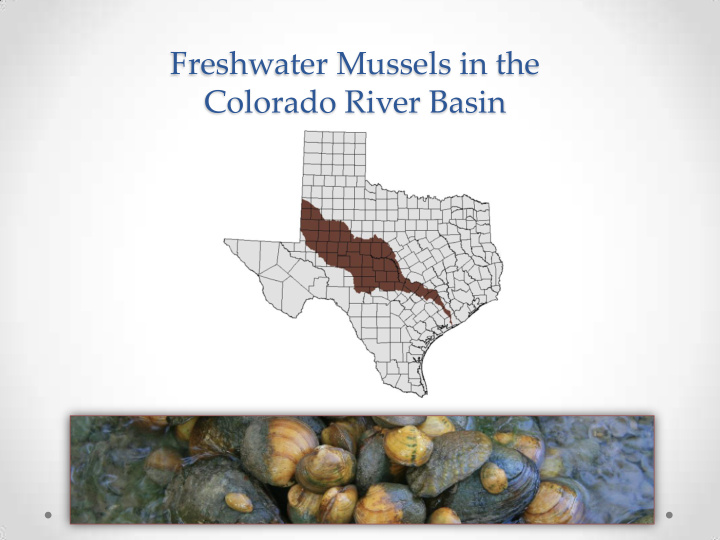



Freshwater Mussels in the Colorado River Basin
Characterizing the Colorado River Basin • 3 rd largest river basin in Texas • Flows from Dawson County to Matagorda Bay • Colorado River is 2 nd largest river but only 6 th largest by annual flow volume • 11 major reservoirs
Demographics in the Colorado River Basin • Population- >2 million Regional Water Planning Areas Region F- 618,889 (2% of state’s o population) Region K- 1,412,834 (6% of state’s o population) • Major cities Odessa, Midland, San Angelo, o Brownwood, Austin, Bay City • Recent challenges Rice farmers (Wharton and o Matagorda Counties) Flood control measures (Austin o area)
Water Use, Supply, and Demand: Region F
Water Use, Supply, and Demand: Region K
Surface Water Quality in the Colorado River Basin • 9 watersheds • 24 water bodies listed as impaired (2010 TCEQ) • 2 watershed protection plans initiated
Fragmentation in the Colorado River Basin Year 1-100 100-500 500-1000 1000-2000 2000+ 1997 409,729 2,506,869 2,644,220 3,644,885 13,806,334 (n = 10,669) (n = 10,503) (n = 3,747) (n = 2,625) (n = 2,133) 2002 429,450 2,410,552 2,371,855 3,349,483 12,617,452 (n = 10,957) (n = 10,263) (n = 3,366) (n = 2,407) (n = 2,006) 2007 459,727 2,503,912 2,275,527 3,219,809 13,383,427 (n = 12,587) (n = 10,736) (n = 3,220) (n = 2,269) (n = 2,182) Change over +49,998 ac -2,957 ac -368,693 ac -425,076 ac -422,907 ac 10 years +1,918 farms +233 farms -527 farms -356 farms +49 farms
Fragmentation in the Colorado River Basin
Market Value in the Colorado River Basin Year $/Acre (Colorado River Basin) $/Acre (Texas Average) 1997 $421 $500 2002 $648 $677 2007 $1,258 $1,196
Texas freshwater mussels • ~300 mussel species in North America; ~50 species in Texas • Many Texas species are endemic • Bottom-dwelling invertebrates • Filter-feeders • Occur in variety of habitats • Most Texas species require free-flowing streams; some can survive in impounded areas
Role in aquatic ecosystems • Food sources for a variety of insects, fish, birds, and mammals • Remove suspended particles and pollutants from the water column, helping to improve water quality • Indicators of environmental quality
Primary threats • Habitat alteration and degradation Water flow alterations, impoundments o Sedimentation o Water pollution o Invasive species o
Number of species per river basin 23 species in Colorado River Basin
Federal listing status • Positive 90-day finding for 9 mussels, Dec 15, 2009 • Positive 90-day finding for 2 mussels, Dec 16, 2009 • Negative 90-day finding for 1 mussel, March 23, 2010 • 12-month finding for 5 central Texas mussels, Oct 6, 2011
Texas Fatmucket Golden Orb 5 Candidate Mussel Species in the Colorado River Basin Texas Fawnsfoot Smooth Pimpleback Texas Pimpleback
What does all this mean… What might be impacted with federal listing? • Potentially, any activity that pulls water out or puts water into aquatic system, or that may directly impact the system (e.g., bridge construction) • Texas Department of Transportation • Existing reservoirs • New reservoirs • Agricultural activities • Power plants • Wastewater treatment plants • Recreational activities
The Scenario • Population in the Colorado River Basin continues to increase at predicted rates (e.g. 100% increase in the next 50 years in Lower Colorado) • Trends in water demand remain consistent (e.g. municipal use will eventually surpass irrigation use) • All 5 candidate species are listed as endangered • Critical habitat is designated Brazos shiners as reference (stream miles plus a buffer) o
The Response • How do we address water quality and quantity concerns in the Nueces River Basin from a conservation finance perspective? 1. What is the program structure? Who are the players? • How does the money flow? “Funding Plan” • 2. What policy changes are needed,? Local, state, federal, none? • 3. What is the implementation plan? Who implements? • When does implementation occur? • 4. How can we scale these ideas up? Can the program be scaled up from river basin • to state or national? 5. What science and analyses is needed?
Recommend
More recommend